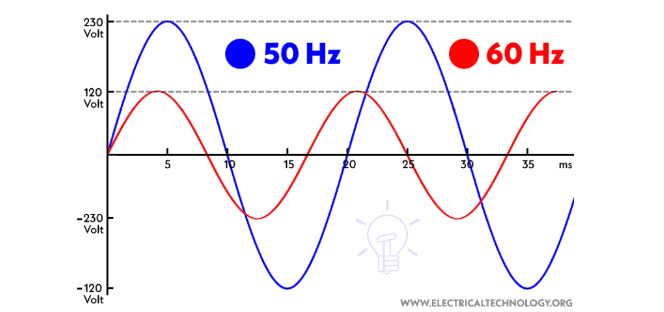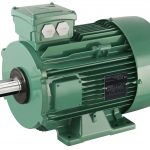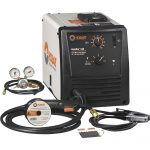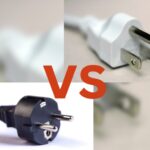Power supply standards vary with countries/regions, especially when it comes to voltage and frequency. In the case of frequency, the 50Hz vs 60Hz are both valid supply standards. In this article, we discuss why 50Hz and 60Hz are the standard frequencies, review what each system means, and their differences.
Why is the Standard Frequency 50Hz vs 60Hz
A quick review of power generation systems reveals the reason for adopting 50Hz and 60Hz as standard frequencies. In a typical power-generating facility, turbines drive generators that convert mechanical energy into electrical power. Then, the voltage of this power is stepped up by transformers and sent via transmission lines to distribution stations. Early light bulbs used a frequency of 133.33Hz, which required using an eight-pole generator. This can be deduced from the expression that relates frequency (f), number of poles (P), and rotor rotational speed in RPM (N).
![]()
However, several factors led to a change and eventual adoption of 50Hz and 60Hz, which include:
- Manufacturing generators with several poles is very expensive. So, OEMs often use two poles as it is the minimum requirement for a generator to function, and it is a cost-efficient option.
- Also, electricity with higher frequency results in significant hysteresis losses and Eddy Current losses in a transformer.
- Generally, turbine efficiency is maximum at rotational speeds between 3,000 RPM and 3,600 RPM.
Considering these factors and substituting values for the number of poles and rotational speed into the frequency equation, values would lie between 50Hz and 60Hz.
50Hz System
The 50Hz supply system enjoys the most adoption globally. Most of Europe, Africa, Australia, and large parts of Asia, and southern South America all use this frequency in power supply. In any application, frequency refers to the cycle time of vibrations, whether they are mechanical, electrical, magnetic, or acoustic.
So, for a 50Hz system, the rotor of the power generator completes 50 cycles per second, which translates to about 3,000 RPM. As a result, the voltage completes 50 cycles per second, while the current alternates direction between the positive and negative values 50 times in a second. Most countries using the 50Hz system also adopt between 220V to 240V for residential supply.
60Hz System
Unlike the 50Hz which enjoys wide adoption globally, 60Hz is less popular. However, it is standard in North America and the northern part of South America that use 110/120V. Like the 50Hz system, the voltage of the 60Hz system completes 60 cycles per second, while the current changes direction 60 times per second. A generator supplying this power would rotate much faster at a rate of 3,500 RPM.

So, why do some countries prefer using one type of frequency over the other?
Differences Between 50Hz vs 60Hz
Although both the 50Hz and 60Hz systems are efficient, they have unique features that make one preferable over the other.
| Parameter | 50Hz | 60Hz |
| Efficiency | The power and corona losses are less, so it is a more efficient system. | Losses associated with this system are higher, especially at the transformer. As a result, requires more copper in power transmission to reduce losses. |
| Size | Machines operating at this frequency are typically larger. | Generally, transformers and other devices are smaller. |
| Power Factor | Has higher power factor. | Power factor is lower. |
| Speed | 50Hz motors operate at a lower speed, which reduces the cooling rate. However, this makes the bearing last longer. | 60Hz motors operate 20% faster than the 50Hz, so it cools quicker. However, the higher speed reduces bearing life. |
| Conductor size | At 50Hz, the effective area of a conductor is larger, so a smaller conductor can serve. | At 60Hz, the effective area of a conductor becomes smaller. As a result, the conductor needs to be larger to carry the same current. |
| Insulation cost | Insulation cost increases with increasing frequency, so it is cheaper at 50Hz. | Insulation costs are higher when operating at 60Hz. |
| Frequency noise | Frequency noise is lower. | Noise increases with increasing frequency, so it is higher. |
| Flickering | Prone to flickering when using certain types of lights. | Flickering is minimal because of the higher frequency. |



